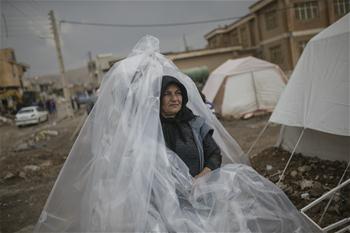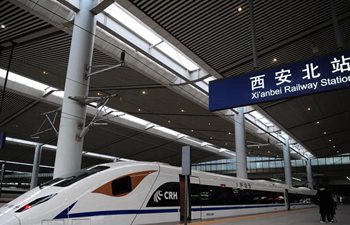by H. L. Bentley
YINCHUAN, Sept. 25 (Xinhua) -- It is early evening in Ningxia Hui Autonomous Region. The air is dry; the heat, just about bearable. The streets of Yinchuan, the regional capital, are a hive of activity.
Families of ethnic Hui are eating outside barbeque restaurants as businessmen in starched shirts walk briskly along the sidewalks beneath bright neon signs promoting seafood, meat and imported vegetables.
A few hundred kilometers south in Xiji County, it is another world: a Martian landscape of miles upon miles of scorched red earth with topsoil so thick and compact it may as well be baked clay. The dusty air swirls around a lake, the banks of which are strangely devoid of vegetation. This lake cannot be used to irrigate the parched fields, as it is salty water. It appeared overnight following a huge earthquake in the 1920s.
Most of Ningxia's 66,000 square kilometers is desert. Much of its arable land has been ruined by human activity. While the Yellow River cuts through the north of the region, the south has just 400 mm of rainfall a year.
Of the region's 2.8 million rural residents, 80 percent live in the south and of them, 380,000 are under the poverty line. For locals, life here is as tough as the land upon which they toil.
For many, education is the only way out, the only way they can take an active role in determining their own future. While training and vocational courses are available for adults, it is the children who bear the heaviest burdens. If they work hard at school, so they are told, they can provide for their families. Many children who have not even hit double figures are acutely aware of this.
Chencha Primary School is the most remote school in the county, about 400 km from Yinchuan. There are just 48 students across five grades at the school.
There is no school bus, no fleet of parents dropping the kids off on the school-run. All the students walk to school.
Headmaster Zhang Qiang is as rugged and weather-worn as the hills surrounding the three squat classroom blocks. While his hands bear the scars of physical labor and his shoes show signs of wear, he speaks with the quiet, commanding tone of a school principal.
"I didn't understand much as a child, so I saw becoming a teacher a challenge. Not only would I learn, but I could pass on my knowledge," he said, a smile washing across his face.
According to the household registration system, 363 families live in Chencha village. In reality, however, only about 180 actually live here, the remainder having left to look for work. Of the families that stayed, 132 are below the poverty line. This means they earn less than 2,300 yuan (about 350 U.S. dollars) a year.
Since the start of the opening up and reform era in the 1980s, China has raised over 700 million people out of poverty, 70 percent of global poverty reduction in the period. At the end of last year, China still had more than 43 million impoverished people, who mostly live in rural or isolated areas not unlike Xiji.
Guo Yunyun is in the final year of primary school. He lives in a courtyard of four structures with his parents and younger siblings. The outer walls of the family compound are made from compacted earth and straw, the traditional building material used here.
The family's main living space is a large south-facing building, which is made from bricks, fronted in tiles, and has a squat, black belly stove in the center of its single large room. One of the older buildings serves as a kitchen, with a huge open-fire stove and walls thick with soot. Another houses the precious motorbike that Mr. Guo uses to get to construction jobs across Ningxia.
Mrs. Guo is a stoic, tremendously proud mother. She cannot drive, and rarely goes to the village proper as the children and the family farmland keep her busy, and close to home. She doesn't think either she or her husband will ever leave the village, but that doesn't stop her dreaming of her children being admitted to the high school in the regional capital.
The downside is separation.
Liupanshan High School, in Yinchuan, is one of two high schools for poor rural residents. Every gifted student is encouraged to sit the school's entrance exam, which, should they pass, would mean they could complete the final three years of high school, and, more importantly, not pay.
The school has 6,000 students across three grades. Each receives a grant from the local education department, and a monthly stipend covers living costs and class material. Of last year's graduates, 106 students from Xiji were offered college places, among whom were graduates of Chencha Primary School.
"This is probably the first poverty relief high school in China," headmaster Jin Chunyu explains as he walks around an exhibition on the school's history.
"We have three missions - to deliver high quality education; to provide an accessible, learning environment for ethnic minorities and the very poor; and to do all this for free."
Liupanshan and the local school in Chencha are as different as night and day.
There is an infectious enthusiasm at Liupanshan, which is absent from the rural primary school. Chencha students are taught by rote: The only objective is to pass the entrance exam. The children at Liupanshan are encouraged to play an active role in their education, to ask "why?" They are confident, both in themselves and their abilities.
"Poverty alleviation should enable people, help them develop skills, rather than just throwing money at the problem," Jin explained.
At the school in Chencha, only the headmaster has been there for more than two years. In Ningxia's poverty stricken area, the number of teachers that retire each year exceeds the number of new recruits.
To fill in vacancies, even just temporarily, teachers are moved around schools. As a result, it is the children who pay for this - their education lacks consistency.
There is a sizable gap between rural and urban education. Each year, Liupanshan accepts 2,000 new students. These are the most promising students from all rural areas in Ningxia. Yet, it begs the question: If the quality of education at Ningxia's lower grade rural schools was as high as in Yinchuan, how many students would be eligible to attend high school, and beyond?
Twenty years ago, the majority of people in Ningxia lived in rural areas. By the end of 2016, of the 6.7 million people who called Ningxia home 56.3 percent lived in urban areas.
This trend seems set to continue as most students at Liupanshan see their futures in the city, but not as migrant workers. This next wave of workers will be armed with qualifications and, more importantly, ideas.
These children are the future of Ningxia. They have experienced poverty first hand, and their knowledge could be a powerful tool in the final push to end poverty in China.

















